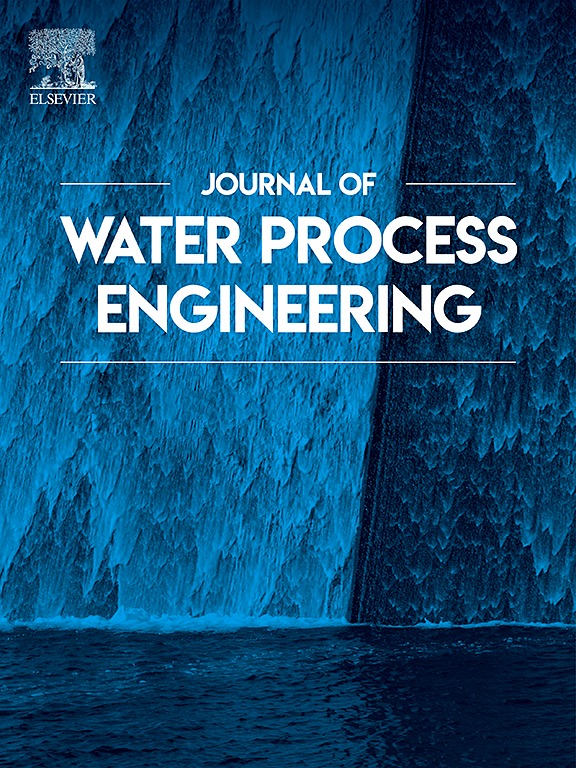纳米级零价铁负载硼掺杂咖啡渣高效激活过氧单硫酸盐降解四环素
IF 6.3
2区 工程技术
Q1 ENGINEERING, CHEMICAL
引用次数: 0
摘要
未经改性的生物炭在高级氧化过程(AOPs)中的实际应用受到其有限的表面官能团和纳米级零价铁(nZVI)固有缺陷(包括颗粒聚集和氧化不稳定性)的限制。为了解决这些问题,研究人员通过对咖啡渣进行改性,合成了硼掺杂比例可控的nZVI催化剂,并对其催化性能、机理途径和操作参数进行了系统评估。在优化条件(0.12 g L−1 nZVI@B1-BC和1 mM过氧单硫酸根(PMS))下,在30分钟内几乎完全脱除(99.1%)四环素(TC)。值得注意的是,硼掺杂使TC的降解动力学比未掺杂的四环素提高了1.51倍,突出了杂原子工程在调整催化剂反应活性中的关键作用。nZVI@B1-BC复合材料在不同的水性基质中表现出优异的鲁棒性,对共存阴离子、腐殖酸(高达25 mg L - 1)和pH波动(3 - 11)具有很强的耐受性。自由基猝灭实验和电子顺磁共振(EPR)分析确定羟基自由基(•OH)和硫酸盐自由基(SO4•−)是主要的活性氧(ROS),而HPLC-MS则阐明了三种潜在的TC降解途径,包括去羟基化、去甲基化和开环反应。本研究促进了生物炭负载的nZVI催化剂的合理设计,并为优化过硫酸盐活化系统用于抗生素污染水的修复提供了可行的见解。本文章由计算机程序翻译,如有差异,请以英文原文为准。

Nanoscale zero-valent iron loaded on boron-doped coffee grounds highly efficiently activates peroxymonosulfate to degrade tetracycline
The practical application of unmodified biochar in advanced oxidation processes (AOPs) is constrained by its limited surface functional groups and the inherent drawbacks of nanoscale zero-valent iron (nZVI), including particle aggregation and oxidative instability. To address these challenges, nZVI catalysts with controlled boron doping ratios were synthesized via coffee grounds modification, followed by systematic evaluation of their catalytic performance, mechanistic pathways, and operational parameters. Under optimized conditions (0.12 g L−1 nZVI@B1-BC and 1 mM peroxymonosulfate (PMS)), near-complete tetracycline (TC) removal (99.1 %) was achieved within 30 min. Remarkably, boron doping enhanced TC degradation kinetics by 1.51-fold compared to undoped counterparts, highlighting the pivotal role of heteroatom engineering in tailoring catalyst reactivity. The nZVI@B1-BC composite demonstrated exceptional robustness across diverse aqueous matrices, exhibiting strong tolerance to coexisting anions, humic acid (up to 25 mg L−1), and pH fluctuations (3−11). Radical quenching experiments and electron paramagnetic resonance (EPR) analysis identified hydroxyl radicals (•OH) and sulfate radicals (SO4•−) as dominant reactive oxygen species (ROS), while HPLC-MS elucidated three potential TC degradation pathways involving dehydroxylation, demethylation, and ring-opening reactions. This work advances the rational design of biochar-supported nZVI catalysts and provides actionable insights for optimizing persulfate activation systems in antibiotic-contaminated water remediation.
求助全文
通过发布文献求助,成功后即可免费获取论文全文。
去求助
来源期刊

Journal of water process engineering
Biochemistry, Genetics and Molecular Biology-Biotechnology
CiteScore
10.70
自引率
8.60%
发文量
846
审稿时长
24 days
期刊介绍:
The Journal of Water Process Engineering aims to publish refereed, high-quality research papers with significant novelty and impact in all areas of the engineering of water and wastewater processing . Papers on advanced and novel treatment processes and technologies are particularly welcome. The Journal considers papers in areas such as nanotechnology and biotechnology applications in water, novel oxidation and separation processes, membrane processes (except those for desalination) , catalytic processes for the removal of water contaminants, sustainable processes, water reuse and recycling, water use and wastewater minimization, integrated/hybrid technology, process modeling of water treatment and novel treatment processes. Submissions on the subject of adsorbents, including standard measurements of adsorption kinetics and equilibrium will only be considered if there is a genuine case for novelty and contribution, for example highly novel, sustainable adsorbents and their use: papers on activated carbon-type materials derived from natural matter, or surfactant-modified clays and related minerals, would not fulfil this criterion. The Journal particularly welcomes contributions involving environmentally, economically and socially sustainable technology for water treatment, including those which are energy-efficient, with minimal or no chemical consumption, and capable of water recycling and reuse that minimizes the direct disposal of wastewater to the aquatic environment. Papers that describe novel ideas for solving issues related to water quality and availability are also welcome, as are those that show the transfer of techniques from other disciplines. The Journal will consider papers dealing with processes for various water matrices including drinking water (except desalination), domestic, urban and industrial wastewaters, in addition to their residues. It is expected that the journal will be of particular relevance to chemical and process engineers working in the field. The Journal welcomes Full Text papers, Short Communications, State-of-the-Art Reviews and Letters to Editors and Case Studies
 求助内容:
求助内容: 应助结果提醒方式:
应助结果提醒方式:


